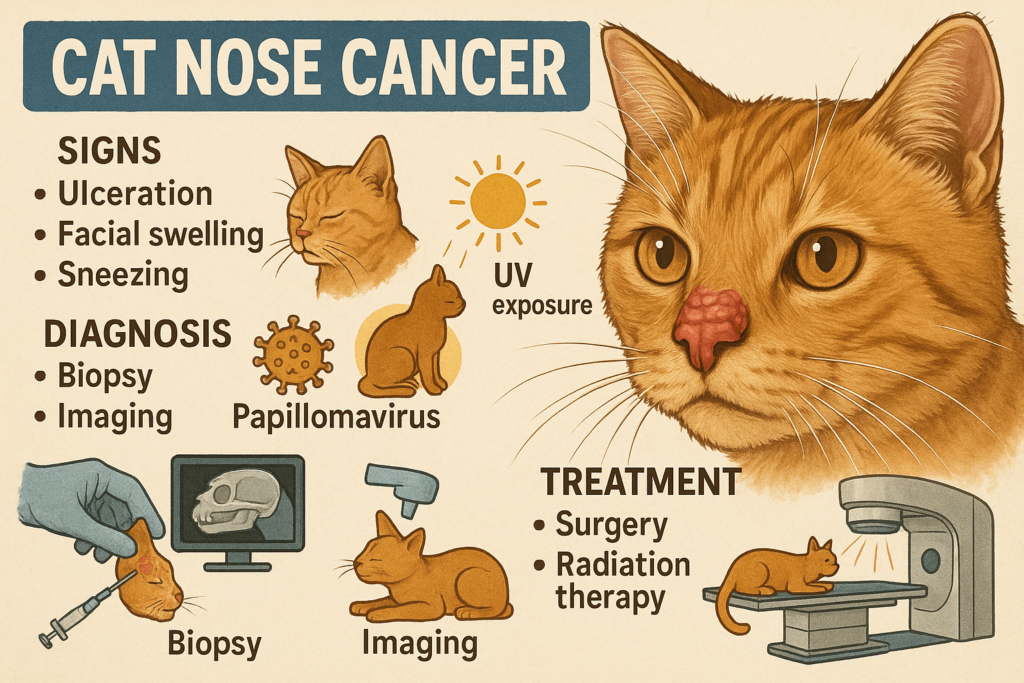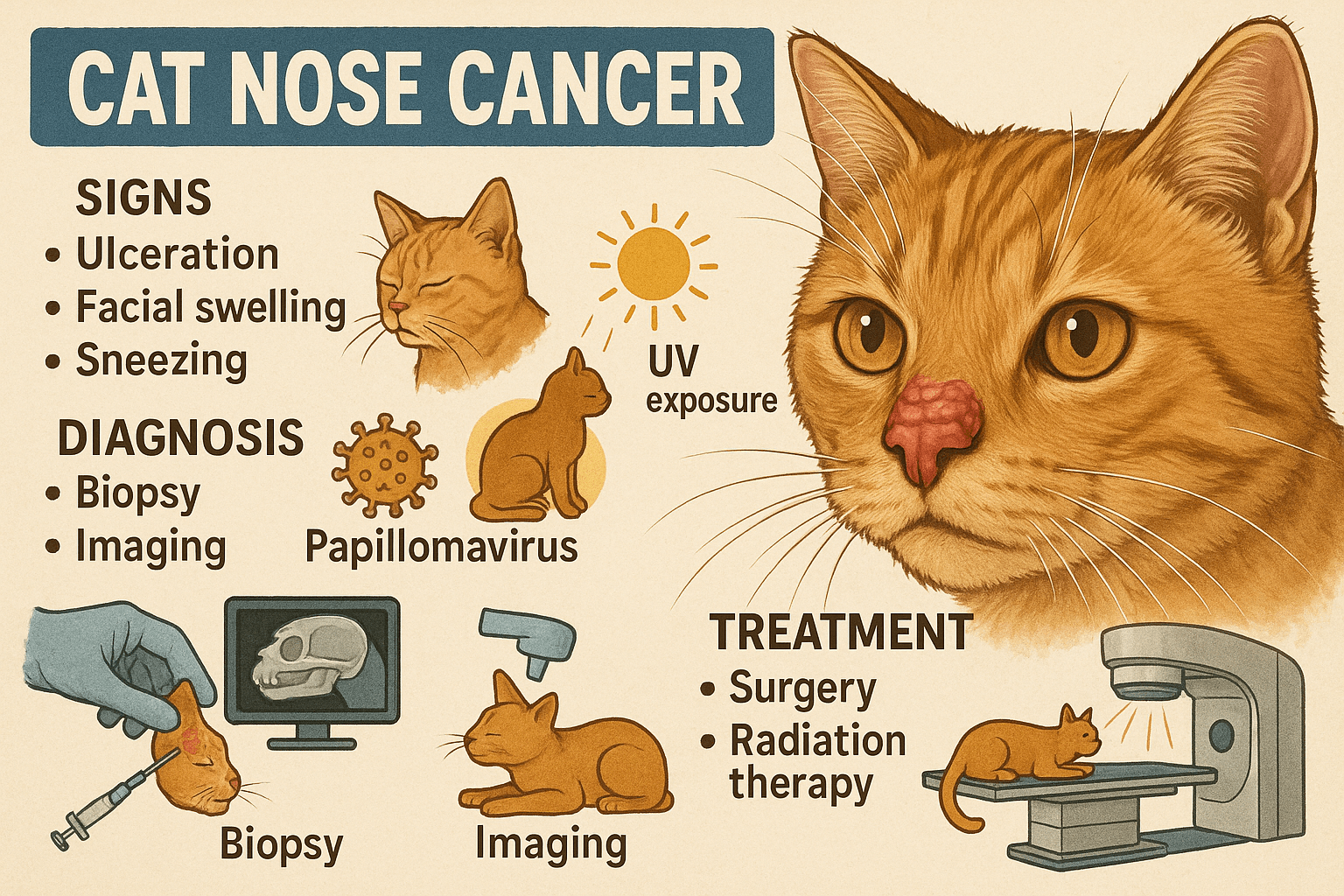Understanding Cat Nose Cancer: Causes, Symptoms, and Care
Cancer in cats is a frightening diagnosis for any pet owner, and when it affects sensitive areas like the nose, it can be particularly challenging. Cat nose cancer, though relatively rare, is a serious condition that requires prompt attention and proper care. Early detection and understanding the signs can make a significant difference in your cat’s prognosis. In this blog post, we’ll explore what cat nose cancer is, its potential causes, symptoms to watch for, treatment options, and how you can support your feline friend through this difficult time. By staying informed, you can provide the best possible care for your beloved companion.
Expert Insight on Cat Nose Tumors
“Tumors in cat noses are often advanced by the time they are diagnosed because they usually aren’t visible externally until they’re quite large. Nasal tumors typically do not spread to other parts of the body (metastasize) but are known to grow into the surrounding bone and tissue, including the brain.”
Common Symptoms of Cat Nose Cancer
Recognizing the early signs of cat nose cancer is crucial for seeking timely veterinary care. Cats are masters at hiding discomfort, so being vigilant about changes in their behavior or appearance can help identify issues sooner.
Persistent Sneezing:
Frequent sneezing that doesn’t resolve could indicate nasal irritation or growths caused by cancer.Nasal Discharge:
Unusual discharge from the nose, especially if bloody or pus-like, may signal an underlying problem.Facial Swelling:
Swelling around the nose or eyes can occur due to tumors pressing on surrounding tissues.Difficulty Breathing:
Labored or noisy breathing may result from blockages caused by nasal tumors.Loss of Appetite or Weight Loss:
Cats with nasal cancer may struggle to eat or lose interest in food due to discomfort or pain.
If you notice any of these symptoms, it’s essential to consult a veterinarian promptly. Early intervention can improve outcomes and ensure your cat receives the care they need.

Potential Causes and Risk Factors for Cat Nose Cancer
While the exact cause of cat nose cancer is often unknown, certain factors can increase a cat’s risk of developing this condition. Understanding these risks can help you take preventive measures and monitor your cat’s health more closely.
Age and Genetics:
Older cats and certain breeds may have a higher predisposition to nasal tumors.Environmental Toxins:
Exposure to cigarette smoke, household chemicals, or polluted air may contribute to cancer development.Chronic Infections:
Repeated respiratory infections or inflammation can sometimes lead to abnormal cell growth over time.Secondhand Smoke:
Studies suggest that cats living in homes with smokers face an increased risk of nasal cancer.Lack of Sun Protection:
For light-colored cats, prolonged sun exposure can increase the risk of skin-related cancers, including those affecting the nose.
By minimizing exposure to known risk factors and maintaining a healthy environment, you can reduce your cat’s chances of developing nasal cancer.
Check this guide 👉Understanding Cat Cancer Survival Rates: Best 7 Expert Tips!
Check this guide 👉Understanding Breast Cancer in Cats: Best 7 Expert Tips!
Check this guide 👉Understanding Cat Lung Cancer Through X-Rays: Best 7 Tips!
Symptoms of Cat Nose Cancer | Preventive Measures |
|---|---|
Persistent sneezing | Avoid smoking around your cat |
Nasal discharge (bloody or pus-like) | Use non-toxic cleaning products |
Facial swelling | Provide a clean, low-stress environment |
Difficulty breathing | Schedule regular vet check-ups |
Loss of appetite or weight loss | Protect cats from excessive sun exposure |
Treatment Options for Cat Nose Cancer
Treating cat nose cancer depends on the type, stage, and location of the tumor, as well as your cat’s overall health. While some treatments aim to cure the condition, others focus on managing symptoms and improving quality of life.
Surgery:
Surgical removal of the tumor may be an option if the cancer is localized and accessible.Radiation Therapy:
Radiation can shrink tumors and alleviate symptoms, especially when surgery isn’t feasible.Chemotherapy:
Chemotherapy may be recommended for aggressive cancers that have spread beyond the nasal cavity.Palliative Care:
For advanced cases, palliative treatments focus on reducing pain and enhancing comfort.Medications for Symptom Management:
Anti-inflammatory drugs or antibiotics may help address secondary issues like infections or swelling.
Your veterinarian will guide you in choosing the best treatment plan based on your cat’s unique needs and prognosis.
How to Support Your Cat During Treatment
Caring for a cat with nose cancer requires patience, compassion, and practical adjustments to ensure their comfort and well-being. Here are some ways you can support your feline friend during this challenging time.
Create a Stress-Free Environment:
Minimize noise and disruptions to help your cat feel safe and relaxed at home.Monitor Eating Habits:
Offer soft, aromatic foods if your cat struggles to eat, and consider hand-feeding if necessary.Keep Them Hydrated:
Encourage water intake by providing fresh water or using a pet water fountain.Follow Vet Instructions Carefully:
Administer medications and attend follow-up appointments as directed by your veterinarian.Provide Emotional Comfort:
Spend quality time with your cat, offering gentle affection and reassurance.
By prioritizing your cat’s physical and emotional needs, you can help them navigate treatment with dignity and love.
Types of Nasal Tumors in Cats
Nasal tumors in cats can vary significantly in nature, ranging from benign growths to aggressive malignancies. Understanding these types helps veterinarians determine the most effective treatment approach.
Benign Tumors:
These growths are less invasive and typically don’t spread to other parts of the body.Malignant Tumors:
Aggressive cancers like squamous cell carcinoma often invade nearby tissues and require urgent treatment.Lymphoma:
This cancer of the lymphatic system can affect the nasal cavity and requires specialized care.Osteosarcoma:
Bone cancer in the nasal region is rare but highly invasive, impacting surrounding structures.Adenocarcinoma:
A common nasal tumor in cats, adenocarcinoma originates in glandular tissue and spreads quickly.
Identifying the specific type of tumor is critical for tailoring treatment plans to your cat’s needs.
Coping Strategies for Pet Owners
Dealing with a cat diagnosed with nasal cancer can be emotionally taxing for pet owners. Employing coping strategies ensures you stay strong while providing the best care for your furry friend.
Educate Yourself:
Learn as much as possible about your cat’s condition to make informed decisions about their care.Seek Emotional Support:
Talk to friends, family, or support groups who understand the challenges of pet illness.Take Breaks When Needed:
Caring for a sick pet can be exhausting—don’t hesitate to step away and recharge.Celebrate Small Wins:
Acknowledge milestones in your cat’s treatment journey, no matter how small.Prepare for End-of-Life Decisions:
Discuss options like hospice care with your vet to ensure your cat’s comfort in their final days.
Taking care of yourself enables you to better care for your cat during this difficult time.
Preventive Care Tips for Long-Term Health
While not all cases of cat nose cancer can be prevented, proactive measures can reduce risks and promote overall feline wellness.
Schedule Annual Check-Ups:
Regular vet visits allow for early detection of potential health issues.Maintain a Healthy Diet:
A balanced diet supports your cat’s immune system and overall vitality.Minimize Environmental Hazards:
Keep your home free of toxins and harmful substances that could harm your cat.Encourage Play and Exercise:
Physical activity boosts circulation and keeps your cat mentally stimulated.Monitor Behavioral Changes:
Pay attention to shifts in eating, grooming, or activity levels, as these can indicate underlying problems.
By prioritizing preventive care, you can give your cat the best chance at a long, happy, and healthy life.
Frequently Asked Questions About Cat Nose Cancer
What are the first signs of cat nose cancer?
Early signs include persistent sneezing, nasal discharge, and difficulty breathing.
What are the first signs of cat nose cancer?
Some cases can be cured with surgery or radiation, but outcomes depend on the cancer’s type and stage.
Can secondhand smoke cause nasal cancer in cats?
Yes, studies show a link between secondhand smoke and nasal cancer in cats.
How long can a cat live with untreated nasal cancer?
Without treatment, survival times vary but are generally shorter due to worsening symptoms.
Are certain cat breeds more prone to nasal cancer?
Yes, brachycephalic breeds (e.g., Persians) may face higher risks due to their facial structure.
Providing Hope and Comfort for Cats with Nose Cancer
While cat nose cancer is a daunting diagnosis, there is hope for improving your cat’s quality of life with timely intervention and compassionate care. By recognizing symptoms early, working closely with your veterinarian, and supporting your cat through treatment, you can make a meaningful difference in their journey. Remember, your love and dedication are invaluable sources of strength for your feline companion. Together, you can navigate this challenge with grace and resilience, ensuring your cat feels cherished every step of the way.
Cuterebra Larvae in Cats: Best 7 Expert Tips! – Expert advice on signs, treatment & prevention of this rare but serious feline parasitic infestation.
Cuterebra Larvae in Dogs: Best 7 Expert Tips! – Expert advice on signs, treatment & prevention of this rare but serious parasitic infestation.
Cat Tumor on Paw: Best 7 Expert Tips! – Expert advice on signs, diagnosis, treatment & care for feline paw tumors.
Panacur Side Effects in Dogs: Best 7 Expert Tips! – Safe usage, common reactions & when to call the vet.





